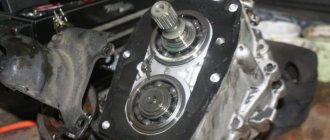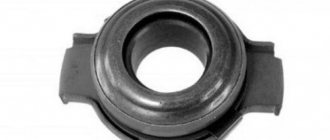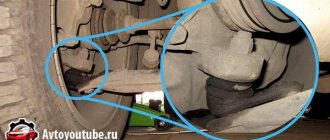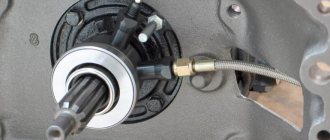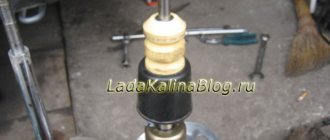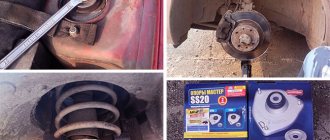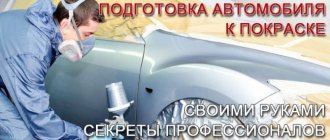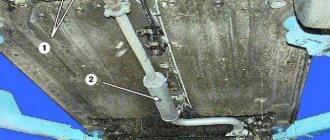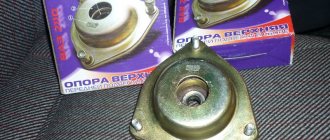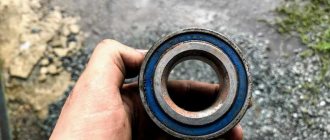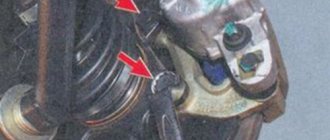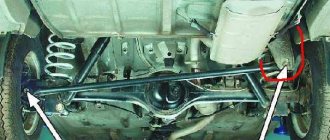If parts in the front suspension of a car malfunction, various squeaks, knocks, clicks and rattles occur while driving. It is clear that this is not just like that. The suspension desperately signals that a diagnosis needs to be carried out, and the sooner the better.
There are not so many parts in the front suspension that even a simple external inspection cannot detect a malfunction. To do this, it is not necessary to have extensive experience in suspension repair. It is important to be careful here, and most importantly, you need to know the structure of the car well and understand what functions the components and parts of the car perform.
Front suspension
Consider the front suspension of a passenger car. Despite the design features of different types of models, all front suspensions are fundamentally the same. True, not all parts can be part of the suspension.
Since the car has two front wheels, many parts can be paired. Here is an approximate list of what is included in the front suspension:
- Steering knuckles (or axles), right and left;
- Front shock absorbers, right and left (can be symmetrical);
- Front springs (mostly symmetrical, but available right and left on some models);
- Front stabilizer, there is only one;
- Stabilizer struts, there are two of them, are rarely asymmetrical;
- The front suspension arms are almost never symmetrical, but they can be upper and lower, and there is also a multi-link suspension;
- Support bearings are always symmetrical, two bearings, but not available on all models;
- Support cups, boots, spacers, etc.
Support bearing
So, support bearings are not available on all models. Their presence is required where the shock absorber itself or the shock absorber strut rotates together with the steering knuckle. The bearing allows the shock absorber to rotate freely in its upper support, without resistance or unnecessary friction.
The support bearing (OP) is located above the front spring, and the shock absorber rod passes through it. Depending on the design features, it can be prefabricated or a single part, but one way or another, the shock absorber is attached to the front side member of the body.
At its core, the part is a rolling bearing; it has a wide cage. The OP must be durable, as it experiences heavy loads when the front spring operates, especially on rough roads.
Support bearing faults
What are the signs of a faulty support bearing:
- when the car is moving, a knocking sound is heard in the area of the right or left front side member of the body, it is especially noticeable when turning and on uneven roads;
- The car has become less controllable and does not immediately respond to turning the steering wheel.
For what reasons can the front bearing fail:
- Poor road conditions;
- Very harsh driving style;
- Factory defects, low quality parts;
- Natural wear of bearings during long-term operation.
It should be noted that support bearings cannot be repaired; a faulty bearing must only be replaced. There can be no talk of any repairs. But the details can be prevented. You can remove the protective cover from the bearing race and treat the inside of the race with lithium grease. Of course, such an operation must be carried out on a working OP.
Volkswagen Polo Sedan - Replacing shock absorbers
In general, I came to the service center to change the shock absorbers (as I was told, the rear ones were dead)
To avoid unnecessary questions, I’ll say right away: Kayaba 339763 Front gas shock absorber “Excel-G” Kayaba 344357 Rear gas shock absorber
Everyone was very interested in telling me which shock absorbers I bought to steal my car, because there are very different opinions and reviews about these Japanese parts. My review is below.
The wheels were removed and the rear shock absorbers were removed very quickly and easily. The old ones were completely killed, when I asked how it turned out (that they were killed), I was shown how they firmly remained in the same position when they were crushed and crushed. Did you understand))
After some manipulations by the craftsmen, the rack was assembled.
What I really liked: before putting the wheel in place, the drums were treated with copper grease so that nothing would stick.
In addition, if you knew about copper grease, there is a gel (I was told that this is a proprietary gel, but this is not entirely true)))) that treats the bolts.
A torque wrench for me is always an indicator of quality of service: all bolts need to be tightened as needed, and not by accident))
How to determine if a support bearing is faulty
It is very simple to determine the malfunction of the OP. You need to open the hood, grab the shock absorber strut with your hand where it is attached to the body and swing it sharply from side to side. If there is play in the bearing or it has crumbled, the strut will move with characteristic clicks. You can do the opposite - grab the wing and rock the car sideways. Then, if the OP is faulty, the body will move, but the stand will remain almost motionless. All movements must be accompanied by knocking in the area of the defect.
Replacing the support bearing
To replace the OP you will need a jack, automotive tools and spring ties. Disassembly order:
- Loosen the wheel nuts.
- We put a jack and lift the car with a jack (you need to be on the safe side - put jack stands under the rear wheel)
- We remove the wheel.
- We disconnect the brake caliper and move it to the side; there is no need to disconnect the brake hose.
- We release the steering knuckle from the bottom from the lever and stabilizer bar.
- We unscrew the fastening of the shock absorber strut to the side member from above and remove the shock absorber with the spring and steering knuckle - the entire structure is assembled.
- We tighten the springs with zip ties and disassemble the shock absorber strut.
- We change the support bearing and reassemble everything in the reverse order.
There is one clever way in which zip ties are not required to replace the OP. While the wheel is not removed, you must first disconnect the nut securing the shock absorber rod. But to replace with a similar method, it would not hurt to have a little experience in repairing the chassis of cars.
In general, the job of replacing a thrust bearing is not very difficult; only normal hands and tools are required.
To avoid serious damage to car systems, you should pay attention to the slightest knock or creaking noise under the hood. If you stubbornly ignore seemingly minor signs of malfunction, then serious problems cannot be avoided. In particular, this is a knocking sound when turning the steering wheel. It may indicate a faulty front strut upper support bearing. Changing the support itself is quite simple, and this process will not be accompanied by serious costs. But if you do not pay attention to the breakdown in time, it will lead to more serious consequences.
Design Features
The support bearing is located between the upper shock absorber cup mount and the upper strut mount. The main purpose is to provide a movable connection between the upper support of the shock absorber strut and the car body.
The unit is a regular ball bearing. In some designs, the bearing may be attached to a plate that rests on the upper spring seat. This is exactly the design used on the Opel Astra F, but this does not make a fundamental difference in the replacement process.
Tool
- spanners, sockets and hexagons of the required size;
- slotted and Phillips screwdrivers;
- spring ties;
- a wire brush for cleaning bolts before unscrewing, penetrating lubricant (WD-40 or its equivalent).
The steering tip can be removed with a special puller or using a hammer. Also, a hammer and an adapter of the required diameter may be required if the outer CV joint is stuck on the splines to the hub (methods for replacing bearings without removing the axle shaft are mentioned in the video, but in most cases it is actually easier to unscrew the hub nut).
Keep in mind that small sets of universal sockets will likely not cover all your needs. For example, when unscrewing the top nut of the shock absorber rod, the rod itself must be held with a hexagon. To prevent the stabilizer link pin from turning, there may be, for example, a recess in it for a Torx, so you won’t be able to unscrew and tighten the stabilizer with a regular head - you need a spanner. Also, in some cars, the CV joint nut may not be the usual hexagon type, but a special multifaceted shape. Be sure to check these points before repair, so that during disassembly the tool is not found to be missing.
The dimensions of the fasteners, as well as the requirements for clamping forces, can be found in the repair and operation manual for your vehicle. If you do not have plumbing experience and a refined muscular sense of the degree of tightening of the nuts, we recommend that assembly be carried out only using a torque wrench. Of course, you won’t be able to undo the threads of the hub nut, but you can ruin the threads that secure the caliper guides.
Removing the shock absorber strut
On cars whose suspension parts have not been separated for a long time, we recommend that the day before repair, clean the fasteners from dirt and fill them with penetrating lubricant or brake fluid.
The described instructions and video will be devoted to replacing support bearings using the example of Skoda Fabia.
- Loosen the hub nut and wheel bolts. Since the clamping force is quite high, it will be extremely difficult to unscrew it alone after lifting the car. Unless you are changing the brake discs along with the support bearings, then you can afford to insert a screwdriver into the disc stiffeners, thereby fixing it in the caliper. The nut can be loosened by asking someone to press the brake pedal firmly. Of course, all these options require more labor than loosening the nut when the car is still on wheels and can be secured with wheel chocks and a hand brake.
- Raise the car and secure it on strong supports. Under no circumstances should the car be constantly hanging on a jack! Wheel chocks must be installed under the wheels.
- Remove the wheel.
- Unscrew the nut securing the stabilizer link to the telescopic strut. Be sure to thoroughly clean the recess under the Torx from dirt. Otherwise, if you mistakenly insert a smaller head due to deposits packed inside, you risk damaging the internal edges when unscrewing the nut.
- Unscrew the mounting bolt of the brake hose mounting bracket.
- Unscrew the steering tip nut. If you do not rotate the tip around its axis, you won’t have to do a wheel alignment after the repair. To remove the tip, use a puller or hit the post pivot arm several times with a hammer.
- Unscrew the hexagon socket bolts securing the caliper to the steering knuckle.
- Rotate the caliper slightly and pull it out of its seat along with the brake pads. Secure the caliper in a suspended position or place something under it. Under no circumstances should it hang on the brake hose!
- Remove the brake disc.
- Unscrew the hub nut.
- Unscrew the ball joint mounting bolts. If the ball is riveted to the lever, you need to unscrew the upper mounting bolt, after which it is best to remove it with a puller. If the distance from the end of the bolt to the CV joint does not allow the nut to be unscrewed, the rivets will have to be drilled out and then replaced with bolts with nuts and washers.
- Knock the drive shaft out of the splines in the hub. The video shows an effective removal method using a hammer drill in jackhammer mode.
- Unscrew the upper bolts securing the front strut support. It is better to do this with an assistant, since nothing holds the stand except these nuts.
Function of front strut support bearings
As the name suggests, the part performs a supporting function. It is the connecting element between the front hydraulic shock absorber strut and the vehicle body. This is a version of a rolling bearing. The part is subject to significant axial loads, which is why it is made of high-strength alloys. And under the road conditions in which modern cars have to travel, the part wears out much faster than we would like. Therefore, it should be checked every 20 thousand km. mileage The worse the quality of the roads you drive on, the more often you need to check it.
To make it clearer where exactly the part is located and what function it performs, you need to remember how the front suspension of the car is designed. For example, let's take a VAZ-2110 car. It has an independent suspension with hydraulic struts. Most modern cars are equipped with the same. The design of the front strut effectively dampens vibrations that occur when the shock absorber spring moves.
Here, special attention should be paid to securing the rack itself. At the bottom it connects to the rotary cam. And at the top – directly with the body. The movable mount is provided by the front strut bearing.
About repairing the front shock absorber cup
When do you have to repair shock absorber cups?
The shock absorber strut cups on the front axle are subject to increased loads, so it is not surprising that they wear out or become mechanically damaged. As a rule, cars come to us for repair due to glasses in the following cases:
- cracks have formed (usually they occur near the base or in the upper part);
- corrosion has occurred on the base or the bowl itself;
- The front shock absorber was damaged in an accident.
You must understand that a crack that appears in the metal will gradually progress, so repairs cannot be postponed.
Replacement or restoration?
When car owners order us to repair the front shock absorber of their car, we first carry out diagnostics. In some cases, restoring this part of the body turns out to be a futile exercise, since the metal will become even more fragile under the influence of heat during the welding process.
Despite this, a competent approach using professional equipment allows our craftsmen to efficiently weld cracks on the front shock absorber cups, eliminating the risk of subsequent deformation.
Replacing the glass bowl
In most cases, repair of front shock absorber cups is limited to replacing only the cups. This work includes the following list of procedures:
- wheel removal;
- removing the shock absorber strut along with the spring;
- drilling the upper bowl;
- removing corrosion and rust from the remaining metal;
- welding another bowl to a glass;
- treating seams with sealant and painting;
- reinstallation of all previously removed elements and parts.
Types of support bearings
There are several most popular types of bearings used in modern cars. These include:
- bearing with built-in ring. This arrangement of the front strut support bearing is considered the most convenient to install. The built-in ring can be external or internal. The main feature of this type of bearings is the presence of special holes for installation. Its installation does not require the use of clamping flanges. The bearing ensures the rotation of parts using both the inner and outer rings;
- with outer detachable ring. The inner ring provides connection to the vehicle body;
- with detachable inner ring;
- single divided. This type of bearing is practically no different from all others, but its peculiarity is that it is made of more durable materials.
Some Tips for Replacing the Front Shock Absorber Upper Mount
- When disassembling, the hub nut should be loosened before you remove the wheel; if the car is already suspended on a jack, it will not be easy to move it.
- If you do not have a ball joint and tie rod remover, the steering tip can be knocked out by hitting the joint joint with a heavy hammer, the blows must be sharp and precise. Even if the tip seriously “boils” in the connection, after several attempts it will still come off.
In general, replacing the support bearings on the front struts is quite simple; to make a replacement, you don’t have to go to a car service center; you can do the work yourself.
Source
Causes of bearing failures
As is the case with increased wear of other car parts, the support bearing often fails due to domestic off-road conditions. First of all, there are a large number of holes and potholes. The support is subjected to greater loads than it can withstand. That is why, when driving frequently on bad roads, the part needs systematic diagnostics.
Another reason is dirt getting inside the bearing. Its design does not provide any protection, therefore it is open to contaminants entering under the car body from the outside. Again, the quality of the road surface also contributes to this.
Low quality characteristics of new components are a common situation in our automotive parts market. Therefore, one should not be surprised that the support rod lasted half as long as the manufacturer promises.
Do-it-yourself rack repair: is it necessary?
Replacing this unit is not a budgetary endeavor, so many car owners prefer to restore it themselves. It is not the entire assembly that breaks down, but its individual components, so during repairs you can only replace a few parts, and performance will be restored.
Attention! Not all shock absorbers can be restored. There are collapsible and monolithic structures (non-removable). It is not advisable to repair the latter, since it is impossible to restore the sawn body to its original condition.
Signs of a faulty front strut support bearings
The most typical sign of support bearing wear is a knocking sound when turning the steering wheel, as well as when overcoming minor obstacles on the road. Significant wear and tear may cause problems with vehicle handling. Its driving performance is impaired, maneuverability and steering are lost.
Due to wear of the bearing, the alignment may be disrupted. When hitting a hole, the part may break completely. In addition, the strut sometimes pierces the body of the car, and this requires more significant costs than the usual replacement of the strut. Then you will have to straighten and paint the iron, and correct possible damage to the suspension.
How to identify a faulty front strut support bearings
Signs that may appear when the bearings are worn do not necessarily indicate this particular malfunction. They are also typical for other breakdowns. Therefore, before you start replacing this part, you need to diagnose the bearing fault. It is as follows:
- we turn off the car, put it on the handbrake or install stops;
- open the hood;
- remove the “glass” cover located on the hub bearing;
- We press the support with our palm and ask our partner to swing the car in different directions. In this case, the puff pastry should not “walk”.
Everything is simple here. If you hear a clear knocking or squeaking sound when rocking, then the bearing needs to be replaced urgently.
Troubleshooting and repair: what to do with springs, boot, etc.
We check all components for wear, mechanical damage, and nicks. We especially carefully inspect the polished surfaces of the inner wall of the cylinder and rod. It makes sense to replace rubber O-rings, seals, and gaskets in any case. Even if they do not show signs of wear, soft rubber loses its properties under the influence of oils. If you disassemble the shock absorber, spend a small amount on consumables.
Tip: When replacing parts, you can change the characteristics of the rack by installing aftermarket parts.
If you thoroughly wash all shock absorber components, consider half the work done. Fine particles of road dirt or wear products from metal parts interfere with the operation of the stem valves. Coked deposits should be removed using strong solvents.
Replacement
Replacing the front support bearings is quite simple. The main thing is to find a really high-quality part, because not all manufacturers can provide supports with a high degree of wear resistance. So, we arm ourselves with the following tools:
- spanner;
- head for disassembling racks;
- spark plug head for ratchet;
- rod nut wrench;
- spring compressors.
And, of course, the prop himself. We will carry out the replacement procedure as follows:
- Jack up and remove the wheel.
- Remove the two nuts securing the front strut to the hub.
- Unscrew the nut from the shock absorber rod, while holding it with a hexagon.
- We remove the stand.
- Compress the spring and remove the support bearing.
- We again clamp the hexagon on the rod and unscrew the nut.
- We remove the bearing, install a new one and repeat all the steps, only in reverse order.
The cause of knocking while turning may be a malfunction of the steering rack, steering shaft or steering cardan. Therefore, after replacing the support, the problem may not disappear. In this case, all of the above systems should be checked.
Video on replacing the support:
Many front-wheel drive cars use MacPherson struts as front independent suspension.
Necessary equipment for work
- Jack, wheel chocks, supports under the car (it is unsafe to carry out work using only a jack).
- Open-end and ring wrenches according to the size of the fastener.
- Spanners with ratchet handle.
- Special key for disassembling the cylinder.
- Flathead screwdrivers of different sizes made of high quality steel.
- Retaining ring removers.
- Oil for replacing the shock absorber (with reserve for pumping).
- An air compressor or a cylinder of nitrogen (carbon dioxide).
The important role of MacPherson struts
But MacPherson struts have another important function - they also serve as steering knuckles. That is, the stand with the wheel hub attached to it can rotate around an axis, which allows the drive wheels to be steered.
Naturally, where there is rotation, a bearing is used; in the case of this type of suspension, a support bearing.
To figure out where the support bearing is installed, let's briefly look at the car suspension structure.
Its main components are:
All these elements are assembled into a single whole, which provides the possibility of compressing and decompressing the spring and moving the shock absorber rod in the body (which is what the suspension is actually for, since vibrations are damped during these movements).
To ensure all this, the rack is assembled like this: a shock absorber is installed in the body and all this is installed in a spring.
To support the spring from below, a cup is used, attached to the body (welded to it).
To ensure that the spring is pressed, another cup is installed at the top, which rests against the support.
The spring extension limiter is the shock absorber rod, the end of which passes through the support and is secured with a nut.
Additionally, the support not only acts as a stop for the spring, it also provides the upper fastening of the strut to the body (it is attached to it with levers from below).
Device
The device of the simplest modification of the OP consists of:
- Get the plates back. It most often contains fastenings to the body (these can be threaded studs or simply holes for bolts);
- Bottom plate. Another support element, the purpose of which is to firmly fix the bearing in place and prevent the outer sleeve from moving under load;
- Bearing. There are several types of them. Basically, it is pressed into the body between the plates so that it sits firmly and has no play.
